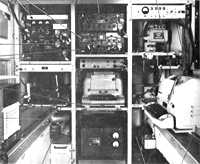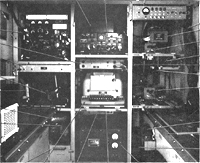| If you do
NOT see the Table of Contents frame to the left of this page, then
Click here to open 'USArmyGermany' frameset |
||||||||||||||||||
72nd Signal Battalion |
||||||||||||||||||
|
|
||||||||||||||||||
|
||||||||||||||||||
|
|
||||||||||||||||||
| Battalion History | ||||||||||||||||||
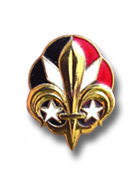 72nd Signal
Battalion DUI
72nd Signal
Battalion DUI |
||||||||||||||||||
1966 |
||||||||||||||||||
(Source: STARS & STRIPES, March 8 1966) |
||||||||||||||||||
The 72nd Signal Battalion was reactivated in Karlsruhe in September 1965. The battalion reports to the 516th Sig Gp. CO of the 72nd is Maj Frederick P. Jones. ORGANIZATION (March 1966): |
||||||||||||||||||
|
||||||||||||||||||
(Webmaster note: another S&S article from October 1966 shows the 547th Signal Co also attached to the 72nd.) |
||||||||||||||||||
(Source: Email from Dave Verneau, 201st Sig Co, 1965-67) |
||||||||||||||||||
I was with the 72nd Sig Bn from Jan 1965 to Dec 1967. When I left I was a SSgt (E-6) in charge of the Facilities Control Section. I was with the 201st Sig Co (TO/E 11-377E55 - Radio Relay) and our sister company was the 169th Sig Co (TO/E 11-500D62 - Radio Relay VHF). We were under the 516th Sig Gp, with its headquarters at Neureut Kaserne. There were other units attached but not in Neureut. We had some units in Mannheim, among others. Q: What is the difference between a Facilities Control Center and a Technical Control Center? A: There is really no difference in the two centers except the name. We would receive signals from our HF and Microwave radios and transfer them to the appropriate subscribers. We were also responsible for the signal quality of our sites, so that we had to know both radio systems and the relays they passed though. At that time we had one SB-675 as our control center and later on my crew built a larger control center in a 5-ton trailer. An SB-675 was mounted on a 2½ -ton truck and was nothing more than a glorified switchboard. We had capabilities to handle 4 spiral four cables and (I believe) 6 26 pair cables along with phone wire for our phone users. The spiral four and some 26 pr cables went to the radios. Other spiral fours went to the crypto sections. Inside we had a glorified switchboard that could handle all the cables with the capability to switch circuits among the cables as needed. We had a local switchboard (SB-22) for our local use. Against the left wall we had a row of TA-182's which were used on the TTY circuits. They were used to provide battery for the circuits and also to switch from 2 wire or four wire as needed. That was about all that it had in it except for a couple teletypes for our use in circuit working. I spent most of my time in Neureut Kaserne except for some TDY. When I made Sp5 we moved into quarters in Smiley Barracks. The last part of my tour, I spent on TDY conditioning the lines for the AUTODIN network throughout Europe. That was the first time most people heard of digital communications. How far we have come since. In that time period we paticipated in the relocation of our units from France. We handled the overflow of traffic that came through our area and passed it on to USAREUR HQs. Most of our time was spent in field exercises, making sure that if we were needed, we were ready as could be to handle it. We also handled back up communication for visiting dignitaries as they toured Europe. It may have been a big thing to some, but to us it was a pain. Having to set up and tear down just to keep up with the visitors was not something we thought of as fun. All traffic, going out and coming in, passed through us, which included code and plain text messages. We also provided UPI and weather info for the commanders of Battalion and Group, as time would permit. |
||||||||||||||||||
|
||||||||||||||||||
|
|
||||||||||||||||||
(Source: USAREUR STATION LIST, 30 June 1967) |
||||||||||||||||||
HHD, 72nd Sig Bn (Spt), located at Neureut Kaserne, Karlsruhe, Germany, is identified as a Dept of the Army unit assigned to the US Army Strategic Communications Command. TO/E is designated as 11-116R55. |
||||||||||||||||||
| (Source: Email from Walter Daugherty) | ||||||||||||||||||
| I was stationed
with Company B, 72nd Signal Battalion from late 1967 to February 1969
when my two years were up and I returned back to civilian life. I
went under the nickname of "Duffy" back then, seems that while at
Fort Gordon someone from Michigan thought it fit with the Daugherty
name. As I recall, when I first got to Karlsruhe and was assigned to Neureut Kaserne, I was assigned to the 516th Signal Company. I believe there was a reorganization shortly afterwards, at which time the 516th became Company B of the 72nd Signal Battalion. I was assigned to an HF platoon and spent most of the summer doing field exercises and lengthy TDY assignments. Some of the guys, those with "top secret" clearances, got TDY assignments to Paris for the ongoing peace talks. I only had a "secret" so wasn't selected for this duty. I am still in touch with my best buddy from those days, he lives in New Mexico. I'm here in southern california and came upon the website while just playing around. Don't know what happened to any of the other guys I was stationed with over there, its been more than 30 years but sometimes seems like yesterday. |
||||||||||||||||||
|
|
||||||||||||||||||
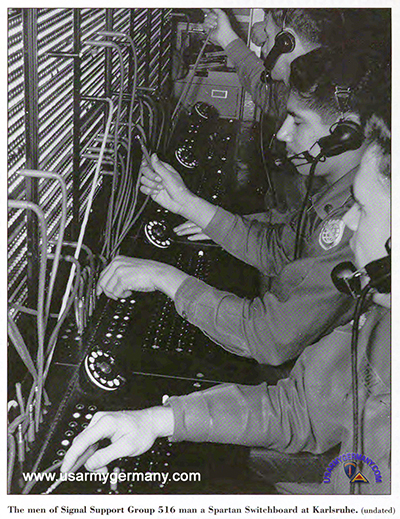 SPARTAN Switchboard, Neureut Kaserne, Karlsruhe |
||||||||||||||||||
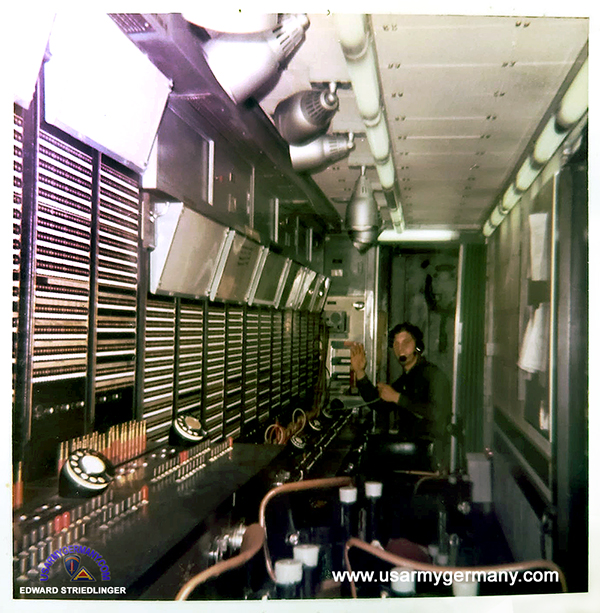 SPARTAN Switchboard, Neureut Kaserne, Karlsruhe, 1973 (Edward Striedlinger) |
||||||||||||||||||
| 1969 | ||||||||||||||||||
| (Source: ECHO (STRATCOM-EUR newspaper), April 16, 1969) | ||||||||||||||||||
| The SPARTAN manual switchboard at Neureut Kaserne, Karlsruhe, is operated by Company A, 72nd Sig Bn. The personnel operating the 223-phone switchboard are split into three 8-hour shifts, and handle an average of 1,500 calls a day. During peak times they connect as many as 300 calls an hour. The manual telephone central office is housed in two semitrailer vans. One contains the relays, frames, storage batteries, and power panel. The other houses nine switchboards cabled in a four-panel multiple arrangement. During field exercises, the two 40' trailers can be transported to a tactical site. |
||||||||||||||||||
1971 |
||||||||||||||||||
| (Source: Email from Howard Hickman) | ||||||||||||||||||
| I was assigned to the 72nd Sig Bn in Karlsruhe from April to Dec 1971, as a SGT E-5 72B. I spent some time in Karlsruhe, but during part of the time, I and about 10 others lived in a large set of one story deserted barracks somewhere between Pirmasens and Karlsruhe (Webmaster: maybe Camp Dahn?). We were close to the French border as we often went over the border for beers. During the day we would go to the man-made caves and set up tactical communications exercises. To eat, we went to a nearby Mess Hall which was used for the MPs guarding a nearby missle site. For entertainment, we travelled to the PX and movies at Pirmasen, and spent alot of time checking out the local castle ruins. We couldn't take pictures of any of the spots where we lived, ate or worked, so I have to rely on my memory. I do have names and photos of the GIs those who were there with me. Does that ring a bell with anyone? Anyone know exaclty where that was? |
||||||||||||||||||
| (Source: Email from Tim Parker) | ||||||||||||||||||
| This is in reference to Howard Hickman's email - see above) I was stationed at Camp Dahn which was designated Signal Operations Detachment (SOD) 72nd Signal Battalion from the summer of 1971 until December 1973 (ETS). I was previously assigned to SOC 72 Sig Bn Neureut Kaserne. In early summer 1971 as a SP4 72B from AIT @ Ft Gordon Georgia. Com Center duty @ Karlsruhe was limited to about 1 shift per month & the remainder was motor pool (Flat tires & spot painting) work on the various tactical communication trucks & equipment. One of our section sergeants told me & several other recent arrivals about a new detachment that was being formed at Dahn Cave and he asked for volunteers. After numerous discussions, debates & warnings to never volunteer, several of us did so & I have never regretted that decision. In regard to Howard Hickman inquiry of location, Camp Dahn was located between Hinterweidenthal & Dahn. In my time there the camp consisted of barracks, NCO private quarters, Polish Labor Service quarters, orderly room, CO office, First SGT office, NCO/EM club, mess hall, 16MM movie theater, HF radio park with 90-foot wooden antenna poles & a small motor pool. The mess hall, movie theater were later additions & Howard is correct about our dining at the 193rd MP mess hall located about one mile south of Camp Dahn. The Dahn Cave communications complex was located about 3 miles west of Camp Dahn & the road there passed a small recreational lake & afforded a good view of Neudahn Castle which has been refurbished. Howard Hickman had a small Fiat Van & he very generously provided transportation for us. I have many fond memories of the friends & experiences I shared at this remote detachment. Thanks for the website ! |
||||||||||||||||||
| (Source: Email from Doug Allen) | ||||||||||||||||||
| I was stationed at Neureut Kaserne in the early 1970’s (1971-73). I was an 31M. I was in Signal Operations Company (Lg. Co.), 72nd Sig Bn, STRATCOM. I worked at Korea site, above the library, next door to the MARS station. I was moved to Tiger 40 on the mountain above Bad Bergzabern. Ran that relay rig for awhile and then moved to Dahn caves when that site opened. Ended up back at Neureut running the supply deuce and ½ back and forth to Mannheim on the laundry run. Best job I ever had. I had the fastest Deuce in Germany (SOC LG 237) and proved it on numerous occasions. Oh the memories. We operated in USAREUR but were headquartered out of Ft. Huachuca, AZ. Korea and Tiger 40 were on the same net. As an operator, I spoke to other operators up and down the line. I don't remember the site names. We used our personal names and call signs. We were "zoned" so to speak in that we could only go so many stations up and down the net. This was a "top secret" net and possibly this limit to our access was intentional and possibly it was the limitations of the equipment. I don't know. I was just a lowly operator. We did channel checks at pre set times and then just monitored the gauges and troubleshot when the alarms sounded. We had a site in Paris that closed (politics) and had one in Ethiopia, Frankfurt and Stuttgart. There also was a site in Thailand. I know this, because our MOS was being phased out due to the antique (tube driven) equipment we operated so that operators were moved around a lot and we shared stories, etc. |
||||||||||||||||||
| 1972 | ||||||||||||||||||
| (Source: Email from Marreece Dean) | ||||||||||||||||||
| Now retired military, I was stationed in KARLSRUHE with the SOC Large Company -- down from the Mess Hall and adjacent to the NCO Club. I arrived in 1972 on my second hitch in the Army after Vietnam. I remember we were standing in formation outside and it was so cold. First sergeant was out in front of the formation fumbling with papers and I had to express myself - 'why stand out here like this doing nothing.' Yes, he did become the first sergeant and I zipped my mouth.
SOC-LARGE was an awesome company of opportunity for signalmen as to TDY and playing sports. You earned the respect -- you got it in return. I do not recall the very short command sergeant major we had but I recall command sergeant major Beck. We had a Spanish first sergeant with dark prescription glasses and SFC Carter at DAHN CAVE was the first sergeant of the 72nd Signal Battalion. I worked for a tall African-American sergeant named SGT GRAY. I was a 72C switchboard operator plus I played for the unit softball team and ran track. Didn't visit Smiley Barracks that much -- No car. Did see the O'JAYS when they came in 1972 or 1973. I am familiar with DAHN CAVE, worked there, too, and very isolated. Did not like the duty there -- Homely pigeons, no where to go but work and barracks. Glad to get back to KARLRUHE. In 1972 or 1973, I was selected to work at BERCHTESGADEN-GARMISCH as a switchboard operator -- FABULOUS DUTY!!! WOW!!! Reforger--TOUGH!!! Have two soldiers I knew there at the company -- one was our orderly room clerk, SP4 Derek (Derrick) Fenner, and one was pole climber, Pedro Johnson. Both now deceased Besides working the switchboards, I was also trained to work in the 72nd Signal Battalion mail room with Hughes and a few others working the mail, 1973-1975. The mail room was up by the Engineer Battalion. Then I was SP5 Marreece Dean. I ENJOYED AND STILL ENJOY THE COUNTRY OVER THERE. I am now 100% disabled, retired military, and social security..Anyone interested into their disabilities and ratings can get on with us at Veteransgroup.com and learn how to get involved. |
||||||||||||||||||
| (Source: Email from Sam Schwartz, Dahn Det, 72nd Sig Bn, 4th Sig Gp, early 1970s) | ||||||||||||||||||
| I was assigned
to the Dahn
Cave unit from the 72nd Signal Battalion at Neureut,
Germany outside of Karlsruhe. I was an E-7 First Sgt with seventy
five soldiers with a shavetail Lt. who had just been married. We were
in a town called Hinterweidenthal and worked in a cave from the 2nd
World War. We were the communications for USAREUR
Forward. I loved that assignment because we were on our
own and had visitors one in a while.The place had been locked up for
years and we had the honor of reopening it and setting up fly swatters
on the mountain above us and a switchboard in the cave along with
a com. center. I sure missed that place after working there six months
until DA found out that I had been misassigned. I was only assigned to 72nd Signal Bn for a year as I was diverted from my original assignment. When D.A. found out about the diversion they sent me to Stuttgart which was my original assignment. There was some kind of deal made to keep some soldier in Stuttgart in the slot I was to fill. I was one of the people who ran the voice control for the Paris Peace Talks while Henry Kissinger was there and I along side the White House signal people in providing the hot lines. Sam Schwartz |
||||||||||||||||||
|
|
||||||||||||||||||
1975 |
||||||||||||||||||
| (Source: Email from Mike Wallenberg) | ||||||||||||||||||
| I was reading the emails about the 72nd. I was stationed in HHC on Neureut Kaserne
from Jan 1975- June 1976. I worked in the Maintenance Shop as a 31J20 teletype repair. During REFORGER of 1975 I worked in the comm center in a cave called Massweiler Cave. We set up our tents at the base of the cave on the pavement. There was a railroad loading area there. I remember a civilian adviser that was assigned to us. His name was P.J. Schwartz. He brought his camping trailer to the field. I married a german girl in May of 1976, I reenlisted for present duty, but was reclassified and sent to Ft. Gordon. I am still married to the same woman today. I visited Neureut Kaserne at Christmas in 2003. There is not much of it left. Only about three buildings are still standing. I appeared to be a gravel pit. The fence is still standing though, and the UP shack at the entrance. Smiley barracks were all the housing and the PX and theater was is now all apartments for the German civilians. There are no soldiers left in Karlsruhe. It was a good duty station. It will always be part of my life as this is were my wife is from. |
||||||||||||||||||
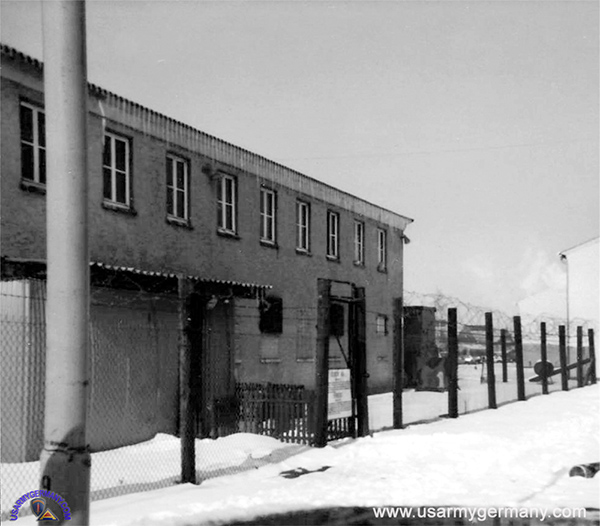 72nd Sig Bn COMSEC Vault at Neureut Kaserne, around 1977 (Tom Albrecht) |
||||||||||||||||||
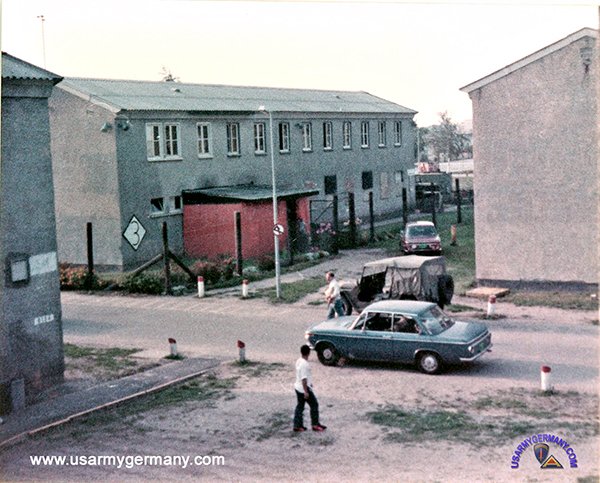 72nd Sig Bn COMSEC Vault, 1977 (Mike Clendenen) |
||||||||||||||||||
| 1977 | ||||||||||||||||||
| (Source: Email from Tom Albrecht) | ||||||||||||||||||
| I was assigned to HHD, 72nd Signal BN as my first assignment after initial AIT training (32G) in Fort Gordon, GA. I arrived in October 1977 as a Specialist 4 (E4) and was stationed there until September 1979, leaving as a Specialist 5 (E5)…. My duties were repair of crypto equipment (KW-7) at the COMSEC Vault located at the Neureut Kaserne, Karlsruhe, Germany. During my time there I participated in numerous Field Exercises throughout Germany, Brussels, and one in England. I was also temporarily assigned to, I believe, the 207th Signal Co for a period of about 2 months. (I commuted daily either in my POV or the Military bus they used daily during the initial move of the company after they were relocated from the Neureut Kaserne to Massweiler, located just outside of Pirmasens, W. Germany.) |
||||||||||||||||||
| 1978 | ||||||||||||||||||
| The 72nd Signal Battalion was transferred from the 7th Sig Bde to 5th Signal Command on 1 Oct 1978. | ||||||||||||||||||
| 1982 | ||||||||||||||||||
| (Source: The Word, Feb 1982) | ||||||||||||||||||
| A long, proud tradition continues by 1st Lt. Richard Belben The 72nd Signal Battalion was originally activated as the 3186th Signal Service Battalion on 15 May 1944 at the Eastern Signal Corps Training Center, Fort Monmouth, New Jersey. On 30 June 1947, it was redesignated as the 72nd Service Battalion. In Japan on 25 January 1950, it was inactivated. It was reactivated on 7 June 1954 and redesignated as the 72nd Signal Battalion at Fort Huachuca, Arizona. The Battalion was then moved to Germany on 25 September 1965. The 72nd Signal Battalion has a long and proud history of faithful and outstanding communications service. During the past 15 years, the 72nd Signal Battalion, has been providing tactical communications support to HQ's United States Army, Europe and 7th Army. Prior to this, in different locations, with ever changing elements, the personnel of the 72nd Signal Battalion have made great contributions to the United States Army, a tradition still continuing today. Some previous "Real World" missions of the 72nd Signal Battalion are as follows: - The Battalion provided communications centers in Paris to support the Vietnam Peace Talks in the early 1970's. - The Battalion supported the United Nations Contingent as it provided mine sweeping and clearing of the Suez Canal. - The Battalion provided communications support to the Algerian Earthquake Disaster Relief Team. The 72nd Signal Battalion has been the first to field several new types of communications equipment in a tactical setting in Europe. These include the first Tactical Automatic Switchboard Service, the first Tropospheric Scatter Multi-Channel Communications System and more recently the first Tactical Satellite Communications Systems. The 72nd Signal Battalion is currently comprised of six separate units, each having its own unique history and honors. The Headquarters and Headquarters Detachment was constituted as the 3186th Signal Service Battalion on 8 May 1944. Activated on 15 May 1944 at the Eastern Signal Corps Training Center, Fort Monmouth, New Jersey, the unit was redesignated as Headquarters, 72nd Signal Service Battalion on 30 June 1954, the unit was redesignated as Headquarters, 72nd Signal Battalion, alloted to the regular Army, and activated on 15 July 1954 at Fort Huachuca, Arizona. Reorganized and redesignated 9 December 1957 as Headquarters Detachment, 72nd Signal Battalion, the unit went through a series of activations and inactivations. The unit's last activation was on 1 January 1972 at Neureut Kaserne, Karlsruhe, Germany. The 207th Signal Company was constituted on 19 February 1942 as the 207th Signal Depot Company, initially activated on 15 May 1942 at Camp Crowder, Missouri and inactivated on 1 November 1945 in Germany. It was activated on 16 February 1952 at Camp San Luis Obispo, California and inactivated on 27 June 1955, at Fort Hood, Texas. On 28 October 1957, the company was activated in Italy and inactivated there on 15 November 1961. On 15 April 1963, it was activated in Thailand. The 207th earned a Meritorious Unit Commendation for the period 15 August to 15 October 1944, and it participated in the campaigns of Tunisia, Southern France, Rhineland, Ardennes-Alsace and Central Europe, during World War II. The 268th Signal Company was constituted on 11 May 1942 as the 268th Signal Construction Company (separate), initially activated on 1 September 1943 at Camp Crowder, MO. Reorganized and redesignated 15 February 1944 as the 268th Signal Heavy Construction Company. Inactivated 9 November 1945 at Fort Monmouth, New Jersey. Redesignated 28 October 1958, as the 268th Signal Company and allotted to the Regular Army. Activated 20 Novermber 1958 at Fort Devens, Mass. Inactivated 22 March 1965 at Fort Bragg, North Carolina. Activated 25 April 1965 at Fort Huachuca, Arizona. World War II campaign credits include: Normandy, Northern France, Rhineland, ArdennesAlsace and Central Europe. The 269th Signal Company was constituted on May 11 1943 as the 269th Signal Construction Company, initially activated on 1 September 1943 at Camp Crowder, MO and inactivated on 2 May 1946 in Germany. On 1 May 1960 it was activated in Orleans, France, and inactivated on 1 July 1967 in Germany. The company was activated on 1 March 1970 in Vietnam. During Vietnam, it earned five campaign credits. World War II campaign credits include Northern France, Rhineland, Ardennes and Central Europe. The 324th Signal Company was constituted on 6 January 1943 as the 324th Signal Company. The activation of the 324th took place at Camp Pinedale, California on 10 January 1943, where it was also inactivated on 14 November 1945. A redesignation, as the 324th Signal Company and allotment to the regular Army occurred on 31 August 1966 with activation on 24 December 1966 at Fort Hood, Texas. The 324th was sent to Vietnam and was inactivated 15 November 1969. Activated 30 June 1971 and inactivated 1 January 1972 in Thailand, the 324th was again activated on 1 June 1974 at Karlsruhe, Germany. The 324th has been awarded the Meritorious Unit Commendation. It's campaign credits include two for World War II and eleven for Vietnam. The 593rd Signal Company was activated in June 1941 at Fort Ord, California as a Signal Construction Company, and inactivated on 30 June 1946 after a rigorous campaign during World War II. It was reactivated again at Fort Lewis during the Korean Conflict and served as a training base for soldiers moving into the Korean theater. The company was inactivated on 1 March 1970 after a gallant campaign during the Vietnam War. The unit was activated again at Preum, Germany on 1 July 1974 and on 30 June 1975, the unit was reduced to zero strength. The 593rd was moved to Karlsruhe, Germany and was activated on 30 September 1975 at Karlsruhe. During Vietnam the unit earned 3 Meritorious Unit Commendations. World War II campaign credits include Normandy, Northern France and Rhineland. |
||||||||||||||||||
| (Source: The Word, Feb 1982) | ||||||||||||||||||
| HF/DCS Entry Platoon augments 72nd Sig Bn's commo team A highly specialized communications platoon from the 181st Sig Co, 43rd Sig Bn, 160th Sig Bde will be assigned to combine its capabilities once again with the 289th Sig Co, 72nd Sig Bn on February 18. The High Frequency/Defense Communications Systems Platoon, led by 2nd Lt. Alan Rak and SFC James R. Heustess, consists of five completely independent Communication Centrals (AN/TSC-38B) with a capability of long haul contingency communications. Each one of the five transportable HF/DCS Entry Teams is virtually selfsufficient. "Each team manages their own vehicles, shelter, rations, fuel and equipment," SSgtLee R. Samuelson, team chief of team #1 pointed out. "Give us our mission and we'll be ready to go where needed," he added. Each team can provide an element such as a brigade headquarters with direct AUTOVON/AUTODIN service. "Depending on our teams' location, we shoot to either England, Greece, Italy or even Ft. Huachuca, Arizona to linkup with a main and establish our support," Samuelson explained. A typical field shot would entail deployment of one or two teams with point to point communications. The platoon has the capability of communication across the oceans with little to no difficulty. During the Fall of 1979, the platoon was challenged to link up a staff headquarters in Germany with an unusual distant end. "My van established communications between Germany and a Navy ship operating in the Mediterranean Sea," Sp5 William F. Coots, Radio/Teletype Operator, said. The unit's transfer to the 72nd Sig Bn will enhance its effectiveness. "Once assigned, we will be co-located with our company and battalion headquarters, a luxury we have not enjoyed," Heustess emphasized. "We will be joining a brigade that has the same tactical or transportable mission," the platoon sergeant added. Lt. Col. Robert L. Berner, Commander, 72nd Signal Battalion, enthusiastically welcomes the new addition to his battalion. "The platoon will enhance our capabilities to support long-distance missions," Berner stated. What are some of the goals the platoon hopes to accomplish? "I hope to be able to take my platoon to the field more often, allowing for more and better training for the soldiers in their respective jobs," Rak replied. (Little does he know, the 72nd Signal Battalion lives in the fieldl) |
||||||||||||||||||
| 1984 | ||||||||||||||||||
| (Source: Town Crier, July 27, 1984) | ||||||||||||||||||
| 72nd holds last gathering before reorganization by Lisa-Jo Nelson The 72nd Signal Battalion, as it is today -- 1,200 soldiers strong, stood together for the last time during recent Organization Day activities. Come Oct. 1, the 72nd will be reorganized, losing approximately half of its soldiers to the newly-formed 63rd Signal Battalion. The new unit, stationed in the Pirmasens area, was formed to accommodate the Army's growing communications needs. According to Capt. Orlando Dixon, Headquarters and Headquarters Detachment commander, the 72nd is presently made up of his detachment and six signal companies - 268th, 269th, 207th, 324th, 593rd arid the 58th. With the break up, members of the 269th and the 593rd will join the 207th, now stationed in the Pirmasens area. Because of the signal soldiers' busy field exercise schedule, it is not often that the entire battalion gets together. "Today is a special day for us. We are the largest active duty signal battalion. Having the chance to be together one last time means a lot to the troops," said Dixon. The Organization Day's celebration began with a pass and review ceremony. Col. Samuel Leffler, 7th Signal Brigade commander, was the reviewing officer. Following the formal ceremony was a day full of sporting activities and family fun. "We tried to involve the whole family throughout the day. We put a lot of effort into activities for the children," said Dixon. Included in the children's activities were a kiddie theater featuring cartoons, movies and popcorn; a three-legged race; a fishing tank where the children fish for submerged toy prizes and and jeep rides for the adventuresome. For the adults, a 10-kilometer race started the day off with the energy level never diminishing. Relay races, softball and basketball championships and horseshoe and volleyball tournaments highlighted the day's competitions. |
||||||||||||||||||
| 1992 | ||||||||||||||||||
| (Source: Email from Ronald Pirtle, 72nd Sig Bn) | ||||||||||||||||||
I was assigned to the 72nd Signal Battalion in Karlsruhe at Neureut Kaserne from about Sep 1992 to Apr 1995. We were organized in a typical fashion: HHC, 58th Signal Company (Tactical Satellite), 268th Signal Company (Heavy Tropo), and 324th Signal Company (DGM).
I was actually assigned to the 58th Sig Co, but attached to HHC to work in the EMF shop. During my time there we, of course, conducted multiple field exercises at various locations: Giessen, Grunstadt, Gieblestadt, Ulm, Grafenwoehr, in and around K-Town to name a few. We also deployed a TacSat and a LENS to Zagreb, Croatia and Camp Able Sentry, Macedonia. I was among the first team to provide DSN service to the Infantry at Camp Able Sentry. I was the maintenance tech for the 93B TacSat in Macedonia and the 85B TacSat in Croatia. Rotations in and out of these location went on for some time, maybe still ongoing today, I'm not sure. Karlsruhe was a very nice community with lots of history and things to do. I really enjoyed my time there. As I was PCSing back to the states in April 1995, the 7th Signal was beginning to pack up and relocate to their current location in Mannheim. |
||||||||||||||||||
| If you have more information on the history or organization of the 72nd Signal Battalion, please contact me |
||||||||||||||||||
|
|
||||||||||||||||||
| Transportable Operations Company | ||||||||||||||||||
| 1969 | ||||||||||||||||||
| (Source: Email from Richard M. Osbourne, Jr.) | ||||||||||||||||||
| In 1969 - 1971 the unit was know as Signal Battalion 72 to distinguish it as a TDA unit. It consisted of (I believe) two normal signal companies and the US ARMY TRANSPORTABLE COMMUNICATIONS COMPANY (USATCC). At the time I left in 1971, the Battalion was reorganized into two companies: USATCC had equipment designed to replace the USAREUR commcenter should the "balloon go up". We had Tropospheric scatter rigs and AN/TC18's as well as KWM2A's. I think those designations are correct - my memory is not what it once was. Perhaps I can find some other info as I look about. ADDITIONAL INFORMATION: I was assigned to the 516th Signal Support Group based outside of Karlsruhe, Germany in early 1969. The Group consisted of 2 TDA Battalions. Signal Battalion 102 was made up of (I believe) two companies: A & B. Signal Battalion 72 was composed of two Companies. The company I was assigned to was the U.S. Army Transportable Communications Company (USATCC). We had three platoons: I am a bit hazy on the exact designations of our equipment, it having been over 30 years ago. Tropo used several giant skeleton dish antennae to broadcast and receive. The "18" rigs were large units that used telephone poles to erect sloping V antennae. The KW's were basically short wave radios. One unit was dismounted and used to operate a "Mars" station. TCC had a detachment located at Baumholder as well. The mission of this unit was to support USAREUR operations and to be ready to take the place of the main signal center in the event of war. Around March of 1971, USATCC was reorganized and became the US Army Transportable Operations Company, while the other Company became US Army Signal Operations Company both under Sig Bn 72. At this time the Group fell under US Army STRATCOM Europe. In as much as all of these units were located at Neureut Kaserne, I assume that subsequent to my departure in Sept 1971 Signal Battalion 72 was reorganized into a TO&E unit and became the 72nd Signal Battalion - however with the Army one can't be sure at this late date. The CO's of Sig Bn 72 were LTC (O5's), USATCC was authorized a Major (O4), but was always commanded by a CPT during my time there. This was not a good time for garrison duty in Europe. Every fiscal year brought "supply constraint due to lack of funds". Much maintenance was deferred. The signal rigs still used vacuum tubes and we lost air time every time we would power up due to blowing one or more of them. The last of "Project 100,000" was still in service as well as disaffected individuals who had been drafted and could not be induced to do more than mark time waiting to get out. I remember "Rosie's" Gasthaus, about 3 blocks from the Kaserne where I lived for several months and learned enough German to get by. The Polish Labor Service was station adjacent to our Kaserne and they and the Germans maintained pre-positioned tracked vehicles. Just putting this down has reminded me of many incidents - some funny, some not so. Anyone who was there during this time will probably remember Hans und Fritz, the guards at the ammo dump (couldn't trust US soldiers to guard our own PLL); the unit police who waived a Soviet auto onto the base without a challenge; the Rads who stole the 100 pair cable during an FTX; the attempt to fire-bomb 516th HQ with Molotov Cocktails (the idiots used diesel fuel - big stain, no fire); my having to draw my weapon during an altercation at the EM club; almost permanent E1 Mikula, the world's greatest scrounger and "Aqua Velva Man". Best of all the time the Col of the 516th decided to have a unit parade. The band was supplied by the Luftwaffe Gp Sud and it was typical "goose step" stuff. Watching the troops, both black and white, try to beebop march to it was priceless... ADDITIONAL INFORMATION In 1969 - 1971 the unit was know as Signal Battalion 72 to distinguish it as a TDA unit. It consisted of (I believe) 2 normal signal companies and the US ARMY TRANSPORTABLE COMMUNICATIONS COMPANY (USATCC). At the time I left in 1971, the battalion was reorganized into 2 companies -- USATCC became TRANSPORTABLE OPERATIONS COMPANY (USATOC) and the others were combined into the USA SIGNAL OPERATIONS COMPANY. USATCC had equipment designed to replace the USAREUR com center should the "balloon go up". We had Tropospheric scatter rigs and AN/TSC18's as well as KWM-2A's. I think those designations are correct - my memory is not what it once was. |
||||||||||||||||||
| (Source: CECOM Historical Office website) | ||||||||||||||||||
| The AN/TSC-18 was the most powerful of three communications centrals (TSC-18; TSC-19; TSC-20) which formed a new family of long-range, air-transportable Army communications systems in the early 1960s. The TSC-18 had a range of 7,000 miles. | ||||||||||||||||||
| 1971 | ||||||||||||||||||
| (Source: Email from Thomas Kean, retired in Germany) | ||||||||||||||||||
| Thanks for the work you put into this web site. I visit often, and always find something new and interesting. I was first assigned to STRATCOM-EUR in February 1971. My duty station was with TOC (Transportable Operations Company) of the 72d Signal Battalion. I was an AIT-trained 72B, but never worked in my MOS. I started out as the co-company clerk. I shared duties with SP Jerry Buffalo. The 1SG was James Huff. The "field first" was SSG Crawford. I moved upstairs to operations within a few months, then transferred over to the Battalion HQ, where I worked as an S-1 Clerk, PIO Clerk, and sometimes sat in as the Bn Commander's clerk. Lu Wienholz was the local national who normally was the Bn Commander's secretary. She knew everything there was to know about Neureut Kaserne. SSG Adelbert Hawley was the S1 NCOIC. The post had its fair share of violence. Molotov cocktails thrown in various directions. Three times that are still relatively clear in my memory: the one that was thrown in the Bn XO's office (Major Truffeau), and the one in the post chapel, and the one near the post gas tanks. This was all reported in the overseas weekly newspaper. While I worked as the PIO, my office was in the dental clinic, across the hall from the Reenlistment NCOs office. That is where I met SSG Fred Terry, SSG Gunther Miller, and SSG Jerry Bennett. Later when I worked as the HHD company clerk, they (the Re-enl NCOs) worked upstairs in the HHD building. The HHD 1SG was SFC Jon Seavers. The library was the next building north of the TOC orderly room. The MARS station was upstairs from the library. I think the other companies in the 72d were SOC (Signal Operations Company) Large and Small (or was it Medium?). I can clearly remember spending evenings (and noon time) in the company day room, which was in the building next to the TOC orderly room, and was under the control of the 1SG. I can remember soldiers from the 72d being assigned TDY to Paris for the Vietnam peace talks. Since the US Army was no longer officially welcome in France, the preparations were many. No ID card, longer haircuts, german license plates on cars, etc. We had soldiers working at remote sites, all of which I cannot remember, but Tiger 40, and the Dahn Cave seem familiar. On one REFORGER, our unit was just southeast of Crailsheim. Our field site was pretty comfortable. We had movies in a tent at night, and even had a soldier who served as a barber. Secretary of the Army, Howard "Bo" Callaway, visited us at that site. I left the Battalion in May 1974. Six months prior to leaving, I was granted TDY on Project Transition to work as a disc jockey with the Canadian Forces Network (CFNS) in Baden-Soellingen. The best six months I spent while on active duty. |
||||||||||||||||||
| 169th Signal Company | ||||||||||||||||||
| 1967 | ||||||||||||||||||
| (Source: Email from Dennis Sholtis) | ||||||||||||||||||
I was in Germany from early March 1967 to Sept 1968. assigned to the 169th Signal Company UHF Group.
|
||||||||||||||||||
| 229th Signal Company / Company "A" | ||||||||||||||||||
| For information on unit's earlier history in USAREUR click on arrow button |
||||||||||||||||||
| Neureut, Germany | ||||||||||||||||||
| 1967 | ||||||||||||||||||
| (Source: Email from Wade Bunte) | ||||||||||||||||||
| I arrived at the 229th Signal Company a couple days before new years day of 1967. I was assigned to the Motor pool and eventually became the 5-ton wrecker driver. The 229th had only arrived to the Neureut Kaserne a few months before this time, prior to this it was stationed at Pirmasens, Germany. Don't actually remember the date but probably early 1968 the 229th was changed to Co. A., 72nd Sig Bn. The 547 Sig Co changed to Co B. I don't remember if the 169 Sig Co changed, designation or not. I was stationed there all of 1967, 1968 and until about May 15th of 1969. At that point my 3-year enlistment was finished. Hope this is helpful in filling out any gaps in the timeline of Companies of the 72nd Sig Bn, 516th Group. |
||||||||||||||||||
| 269th Signal Company | ||||||||||||||||||
| France | ||||||||||||||||||
| (Source: STARS & STRIPES, April 25, 1964) | ||||||||||||||||||
| European Data Gateway Station | ||||||||||||||||||
| The European Data Gateway Station at Maison Fort, France is under the direct control of the 269th Signal Company. The station handles data traffic between European points and the United States and acts as net control station in the Com Z data network. |
||||||||||||||||||
| Germany | ||||||||||||||||||
| 1976 | ||||||||||||||||||
| (Source: Email from Paul Giblin, 269th Sig Co, 1976-77) | ||||||||||||||||||
| I was assigned to the 72nd Signal Battalion (the "Seven Steps to Hell") in Germany from January 1976 through October 1977 - My MOS was 26V20 while stationed in Germany and my rank was SP4 when I ETS'd in October of 1977. My particular unit, the 269th Signal Co., was based on Neureut Kaserne. I was actually assigned to an out-site for my entire time, a place called Massweiler, which was located just outside of Pirmasens, W. Germany. There were approximately 30-35 of us stationed at the Massweiler facility. It was by far, the absolute best duty station I had ever been assigned to. We were a communications repeater site operating 24 hours a day and had an LOS microwave system on top of the hill (which is where I worked) with a Tech Control facility at the base along with a DSS system. We also had a barracks at the base with one of the best mess halls in the Army! Although I can't remember too many of the folks I was stationed with... I do remember a few: SSG Ron Anderson and his wife Liz; SP5 Phil George; SP4 Andy Hill; "Frenchy"; "Rooky"; SGT Lisch ("Scratch") from Texas, his ex-wife; also a SGT and a German girl I dated while there - Ulrike Leimbach. We used to work three 12-hour shifts "on" and then had 3 days off. In our off-time, we hung out at "Willey's" Gasthaus in the village of Massweiller - just over the hill and through the fence... what a great time we all had!!! For a Mark-80 we could buy a liter of Parkbrau beer and for 3 or 4 Marks we could buy a wonderful Schnitzel dinner... we lived like Kings on our measily $155 a month salaries! We had the best stereo systems money could buy, we traveled when we weren't on duty and we enjoyed life to the fullest... needless to say, it was a great time! |
||||||||||||||||||
| 1977 | ||||||||||||||||||
| (Source: Email from Mike Clendenen) | ||||||||||||||||||
| I was assigned to the 269th Signal Company, Neureut Kaserne, 1977-80. | ||||||||||||||||||
| MODERNIZATION OF US FACILITIES (MOUSF) | ||||||||||||||||||
| A massive renovation program of barracks, mess halls and other troop buildings on many kasernes in USAREUR was initiated in 1968 and continued well into the 1970s. Known under various names - Stem-to-Stern, MOUSF or Offset Program - the renovation efforts were initially financed using USAREUR OMA funds, and later, through funds provided by the German government under an agreement between the US and Germany to offset the balance of payments cost of stationing US forces in the FRG. Soon after arriving at Neureut, Mike Clendenen was able to observe the process as several of the 72nd Sig Bn buildings underwent renovation work. Below are several photos showing one of the phases of building renovation: the sandblasting of the outer walls of each building before it was repainted. |
||||||||||||||||||
| 1980 | ||||||||||||||||||
| (Source: Email from Brian Penix, HHD, 72nd and 269th Sig Co, 1980-82) | ||||||||||||||||||
| I found your website while
looking for things related to my old Army units and I decided to drop you a
line and tell you about my time there. So here goes... I was assigned to HHD 72nd Signal BN when I arrived to my first duty station after AIT. I was a Field Radio Repairman (31E10) and the year was 1980. At that time, all 31Es were assigned to HHD but about 4 months into my service there it was determined that HHD wasn't authorized any 31Es so it was decided to reassign us to the various companies. I was reassigned to the 269th Signal Company as the only radio repairman in a company that had 24 radio-teletype rigs (commonly called "RATT-Rigs"). Along with me came Norman, the teletype repairman. The unit had 12 AN/GRC-122s and 12 AN/GRC-142B rigs. The 142 was simplex while the 122 was full duplex (meaning they can send and receive at the same time). Often, they would do it while mobile! That was fun! |
||||||||||||||||||
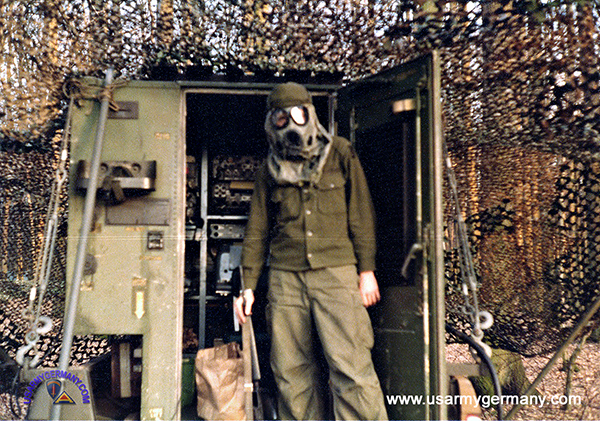 Mike Clendenen with gas mask during a gas attack exercise. Behind him is the HF rig with some of the GRC-122 equipment visible inside the shelter |
||||||||||||||||||
| My responsibilities not only included those 24 rigs but also the Cemetery Net and the Weather Net (located in Heidelberg). The last two networks were "live" ones used for real world events and could suffer no down time. Both Norman and I decided to cross train each other so that we at least would be able to identify where problems existed and fix minor ones without the need to call the other. A while through, they decided we needed some sort of supervision and decided to put the NBC NCO, SGT DiAngelo, in charge. That was a fun time trying to teach him about commo repair! It made sense in a strange way since 31E is responsible for repairing the chemical detectors in use at the time (something that came as a surprise to me!) Cemetery Net It was five AN/FRC-93 radios in a van mounted on a deuce and a half. Damned thing sat in the field most of the time. In fact, one of their tests was to jump site -- essentially drive around the block and re-setup. It was a disaster! Only 2 radios worked after that. You see, FRC-93s are tubed sets. The rattling they took on the cobble stone street shook them too badly. In fact, that prompted Captain Jenkins (the CO at the time) to dip into the "war stock" to replace the van.....What did they get? More FRC-93s! I was in tears of laughter! An AN/FRC-93 is the same as a Collins KWM-2 pictured here: |
||||||||||||||||||
|
||||||||||||||||||
| Weather Net The "Weather Net" was simply one of our rigs (AN/GRC-122B) that was stripped and put into a building in Heidelberg. It provided 24 hour weather service reports to headquarters there. Those reports are what the Air Force used for weather data transfer to all their airstrips. It wasn't officially counted in the TO&E for the unit but I was still the one to be woken up at 3:00 AM when it went down. Most of the people in the 269th were Radio Teletype Operators (05C) and they required support such as me, motor pool staff, supply staff, etc. The reason I was actively sent to the 269th instead of staying in the HHD radio shop was because the operators realized that if their rig was down, they didn't have to go to the field. The CO got me there mainly to keep them all up so the first thing Norman and I did was rewire most of the rigs as well as keep all the Preventive Maintenance Checks and Service (PMCS) records for them. That is why I remember what they are to this day. The funny thing is, in AIT I didn't do too hot in the RATT-rig testing and had to take it twice! My first duty assignment would be a company of the retched things! By the time I left though, I could fix one in my sleep in under 15 minutes. I recall vividly the capture of General Dozier (http://en.wikipedia.org/wiki/Red_Brigades#Kidnapping_of_James_Dozier) in 1981 and the subsequent terrorist alert we all went on. That was the toughest time for me the whole time I was in Europe. All-in-all, I had a very good time traveling all over Europe mostly on TDY. I have been to England, Italy, Sicily, France, and all over Germany. Wherever it was decided to send HF commo, I usually wound up going there at some point. I was the first one to sign for and use the only repair van the unit had that was mounted to a deuce and a half that was reassigned from the mess hall! That truck was a mess indeed. We parked it outside of the motor pool and wired it up to their electric source when not in the field with it. That was where we did our day-to-day work out of. Sadly, when my time for rotation came up, the extension I put in failed to pass and I was rushed out in less than 48 hours to Ft. Hood, TX. That was a big task since you had to run between all the barracks (Gerszewski Barracks, Smiley Barracks, and back to Neureut Kaserne) just to out process from the various departments. At my final reenlistment interview at Ft. Hood I was asked what it would take to get me to reup. My answer was a permanent assignment to the 269th with the further guarantee of never returning to Ft. Hood again. They told me they could reassign me to the 269th but there was 100% chance of returning to Ft. Hood in 2 years. I said no thanks and ETSed. Tour of duty: 1980-1982 Rank when assigned: Private Second Class Rank when reassigned stateside: Specialist Fourth Class ADDITIONAL INFORMATION A little on the equipment though. Both types of rigs had at least one TT-76 and one TT-98. The TT-76 was a paper tape semi-automated teletype and was good for short bursts of transmission times. That is important when you have 10,000 volts, 1000 watts "hear I am" signal going out. Even in "low power" mode you were pushing out 200 watts. The TT-98 was solely printed page. Typically, the operator would type up the message on the 76 producing a paper tape that he later fed into the reader on the side of the unit. As soon as he hit the send, the thing would clatter on through the whole tape. It sure beat the old TT-4s I could tell you (of which this unit thankfully had none). Mission of the 269th Sig Co As I remember it, it was to provide both secure and insecure HF communications throughout the European Command in both fixed and mobile configurations. The RATT had TSEC/KW-7 cryptographic units and could send / receive secure teletype. It couldn't secure voice or CW Morse though so it was used mainly for the printed stuff. That is why I traveled a lot. Remember, this was before the Berlin Wall came down and the Cold War was still going on. Europe's concern was the Soviet countries more than anything else. The unit was an outstanding one to be in in those days and I am damned proud of my service there. The combination of real world communications as well as test exercises added spice that is a rarity in military life. |
||||||||||||||||||
| 324th Signal Company | ||||||||||||||||||
| 1989 | ||||||||||||||||||
| (Source: Email from Fryan D. Booker) | ||||||||||||||||||
| I was stationed with the 72nd Signal Battalion from March 1989 through April 1992. When I arrived, I was a Warrant Office One assigned to the 324th Signal Company to manage the TTC-39A tactical voice switches. These were brand new, just fielded by GTE (now General Dynamics). They were a combination analog and digital tactical switch, capable of handling numerous communications assets in large tactical networks. Along with the switches came new UHF and VHF radio vans. The 324th also had a TYC-39 tactical data switch, two tactical remote communications centers (TSRT), and several tactical data centers. There was also a platoon of "cable dogs," the most important and hardest working signal soldiers in the military. The 324th was the largest signal company in the 7th Signal Brigade at the time. Our mission was to handle theater level communications. Also in the battalion was the 268th Signal Company (Tropo), 58th Signal Company (Satellite), and Headquarters Company. The 269th Signal Company was inactivated shortly after I arrived. I was eventually moved up to battalion S-3 and was also the S-2 Security Officer. We went on numerous exercises throughout Germany including REFORGER 90. In additions to communications, the 30 and 60 KW generators that the TTC and TYC were equipped with provided tactical power for the entire operations sites and were operated and maintained by the signal soldiers with the power/generator maintenance personnel. Desert Shield/Desert Storm, provided our first wartime deployment since the Vietnam War. The TSRT tactical communication centers were the first assets to deploy to Saudi Arabia, to support the CENTCOM Headquarters. Later, the other three battalions of the 7th Signal Brigade; 1st Signal Battalion, 44th Signal Battalion, and the 63rd Signal Battalion deployed to Saudi Arabia along with the 268th Signal Company. Operation Provide Comfort, the protections of the Kurdish people in Northern Iraq toward the end of the conflict would have most of the 72nd Signal Battalion and those assets of the 44th Signal Battalion located in Karlsruhe deploying to Eastern Turkey and Northern Iraq, at first supporting the 10th Special Forces Group and later the coalition forces providing communication assets. I stayed deployed in Turkey until October 1991. I finished my army career at Fort Gordon with the 63rd Signal Battalion. Many of the 72nd signal soldiers were now there and we displayed the knowledge we had gained in both peacetime and war. |
||||||||||||||||||
| 593rd Signal Company | ||||||||||||||||||
| 1984 | ||||||||||||||||||
| (Source: Town Crier, November 2, 1984) | ||||||||||||||||||
| 593rd Signal
Company communicates no more by Dave Bristow and Eugene Thompson The orange and white colors of the the 593rd Signal Company, 72nd Signal Battalion, will wave no more. Last week the company, located at Neureut Kaserne, was deactivated. But, the picture is not as bleak as it appears. Many soldiers of the 593rd have been reassigned within the 72nd Sig. Bn. and one platoon went to the newly activated 63rd Signal Battalion. Most of the soldiers will continue to do the same jobs as they were doing for the company. The Army has a reason for disbanding the signal unit. By reducing the size and scope of the command of the 72nd Sig. Bn. and by giving some of its missions to the 63rd Sig. Bn., the Army wants to improve unit communications support to USAREUR war headquarters. Stationed at Neureut for the past two years, the 593rd Sig. Co. was composed of five platoons -- 215 soldiers, 97 vehicles and 45 generator sets. The mission of the company was providing long and short haul multichannel communications from USAREUR to major subordinate commands. During the deactivation ceremony, the Karlsruhe community "Commander's Trophy" was presented to Capt. Jon B. Christopher and the 593rd soldiers by Deputy Community Commander Col. Joseph A. Monday. The trophy is awarded yearly to the unit with the most active sports program and greatest participation within the Karlsruhe Military Community. It is presented on a point system. The 593rd had a proud history which included combat during the Vietnam War. In establishing communications throughout the Saigon and Cholon region, the company fought in 12 combat campaigns, earning three Meritorious Unit Commendations. The company sustained heavy casualties at Phu Bai, Vietnam, in 1970 and was deactivated that year. In 1974, the company was reactivated and moved to Karlsruhe. (Editor's note: SSgt. Eugene Thompson is the public affairs noncommissioned officer-in-charge for the 72nd Signal Battalion.) |
||||||||||||||||||
|
|
||||||||||||||||||
| Related Links: |
||||||||||||||||||
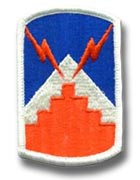
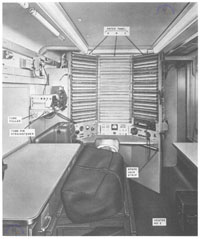
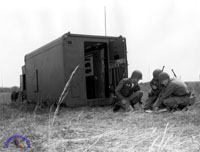
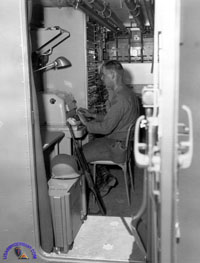
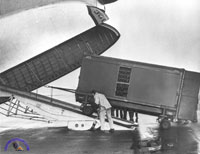
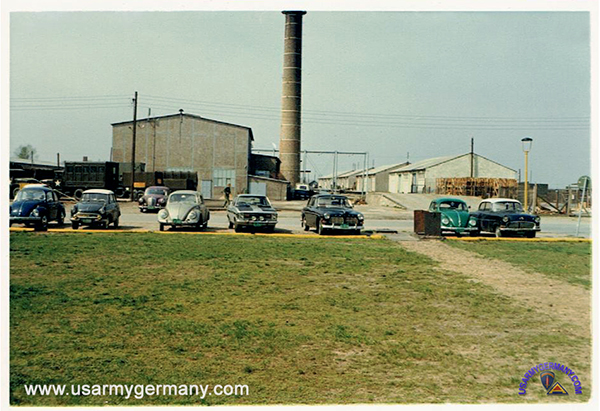
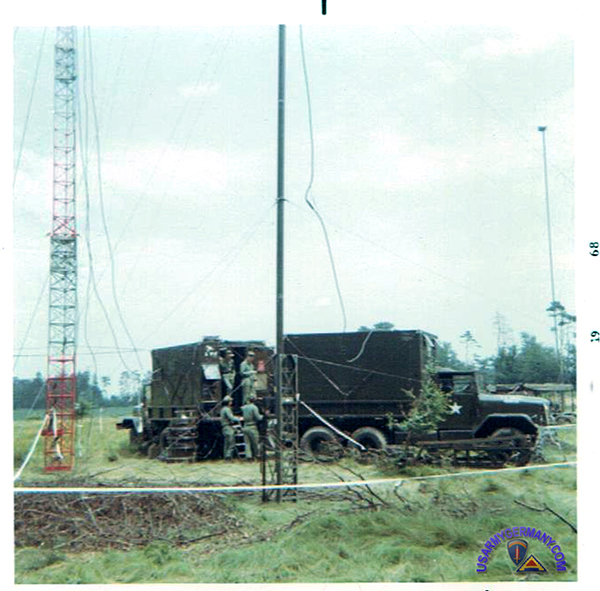
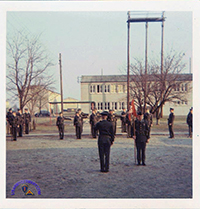
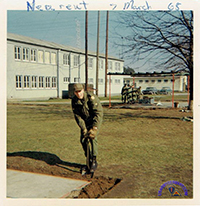
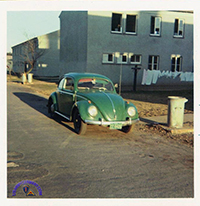
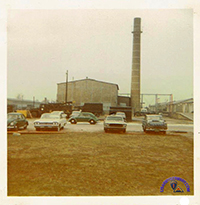
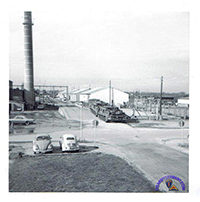
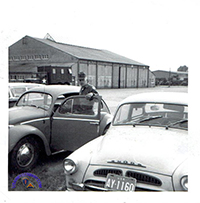
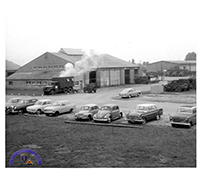
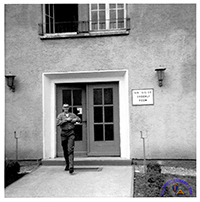
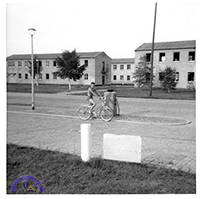
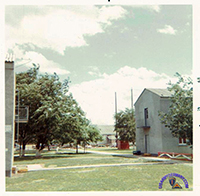
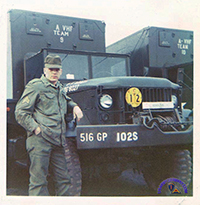
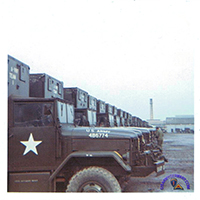
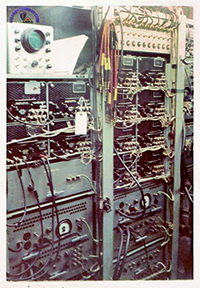
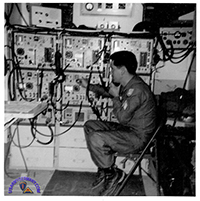
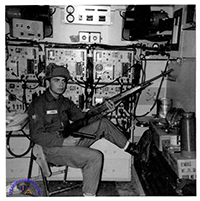
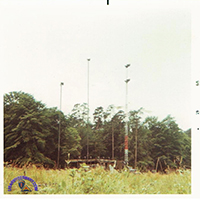
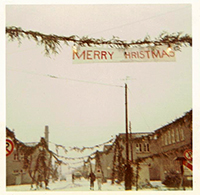
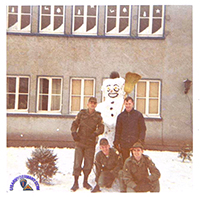
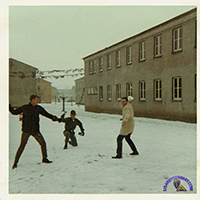
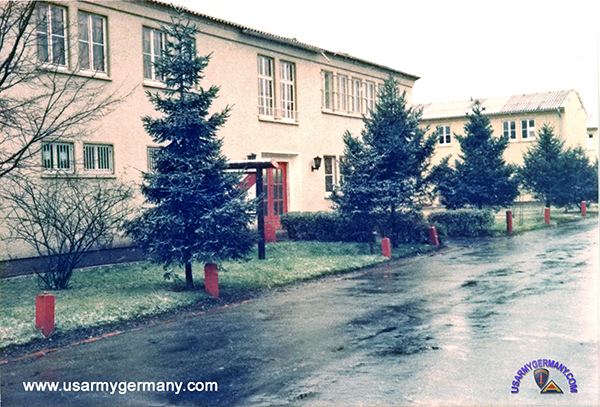

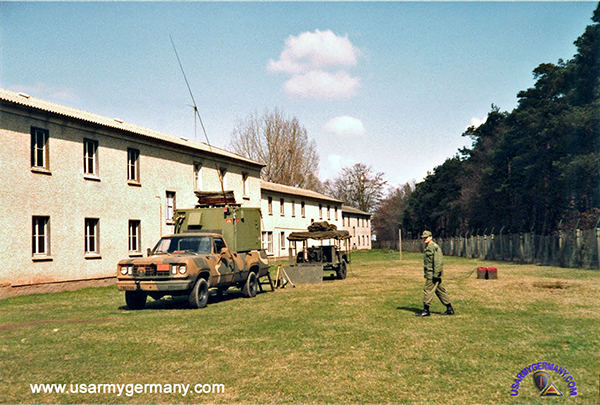
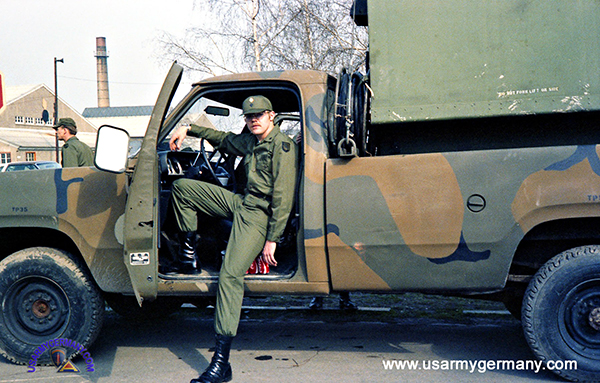
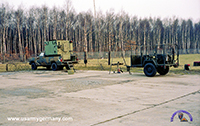
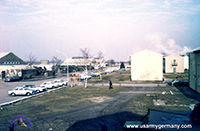
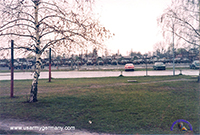
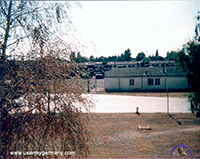
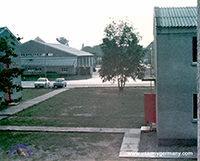
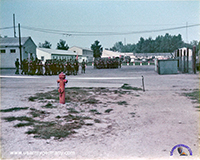
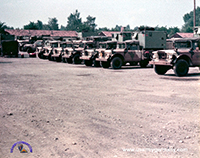
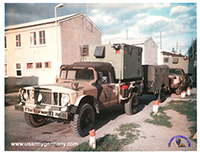
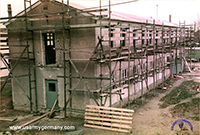
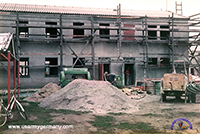
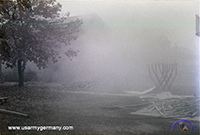
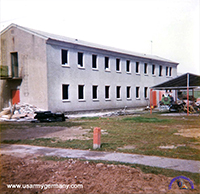
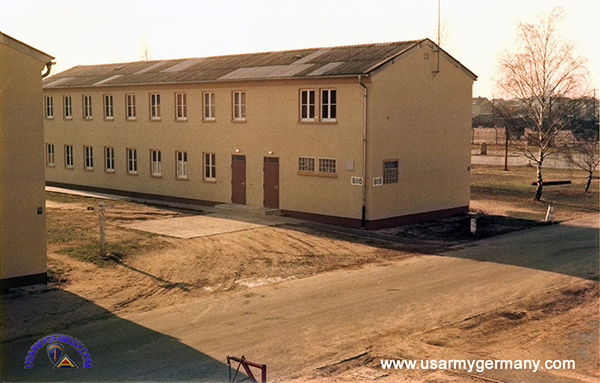
 Dec 1977 - Mike Clendenen 600.jpg)
